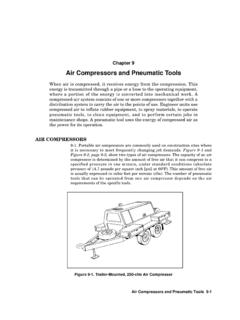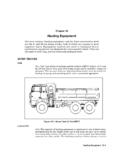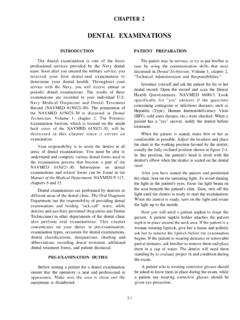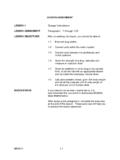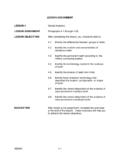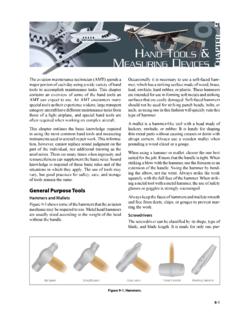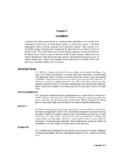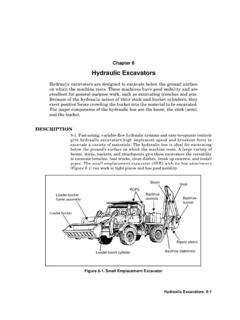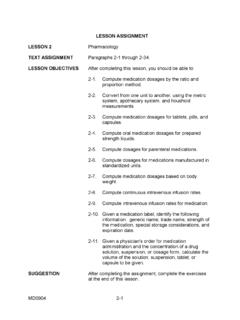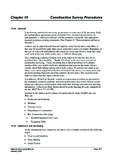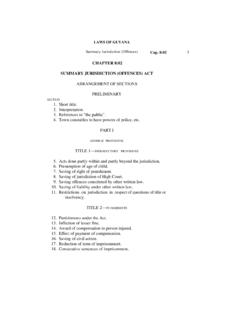Transcription of Chapter 2
1 Dozers 2-1 Chapter 2 DozersDozers (tracklaying crawlers or wheel tractors equipped with a blade) areperhaps the most basic and versatile items of equipment in theconstruction industry. Dozers are designed to provide high drawbar pulland traction effort. They are the standard equipment for land clearing,dozing, and assisting in scraper loading. They can be equipped with rear-mounted winches or rippers. Crawler tractors exert low ground-bearingpressure, which adds to their versatility. For long moves between projectsor within a project, transport dozers on heavy trailers. Moving them undertheir own power, even at slow speeds, increases track wear and shortensthe machine s operational life. DESCRIPTION2-1. A crawler dozer consists of a power plant (typically a diesel engine)mounted on an undercarriage, which rides on tracks. The tracks extend thefull length of the dozer. There are two classifications of military dozers, basedon weight and pounds of drawbar pull.
2 The light class (about 16,000 poundsoperating weight) includes the deployable universal combat earthmover(DEUCE) (Figure 2-1). The medium class includes dozers having an operatingweight of 15,000 to 45,000 pounds (Figure 2-2, page 2-2).Figure 2-1. DEUCE, Light-Class DozerFM 5-4342-2 Dozers Figure 2-2. Medium-Class DozerBLADES2-2. A dozer blade consists of a moldboard with replaceable cutting edges andside bits. Either the push arms and tilt cylinders or a C-frame are used toconnect the blade to the tractor. Blades vary in size and design based onspecific work applications. The hardened-steel cutting edges and side bits arebolted on because they receive most of the abrasion and wear out rapidly. Thisallows for easy replacement. Machine designs allow either edge of the blade tobe raised or lowered in the vertical plane of the blade (tilt). The top of theblade can be pitched forward or backward varying the angle of attack of thecutting edge (pitch).
3 Blades mounted on a C-frame can be turned from thedirection of travel (angling). These features are not applicable to all blades,but any two of these features may be incorporated in a single BLADE2-3. Use straight blades for pushing material and cutting ditches. This bladeis mounted in a fixed position, perpendicular to the line of travel. It can betilted and pitched either forward or backward within a 10 arc. Tilting theblade allows concentration of dozer driving power on a limited length of theblade. Pitching the blade provides increased penetration for cutting or lesspenetration for back BLADE2-4. Angle blades, which are 1 to 2 feet wider than straight blades, are usedmost effectively to side cast material when backfilling or when making sidehillcuts. Use an angle blade for rough grading, spreading piles, or windrowingFM 5-434 Dozers 2-3material. It can be angled up to a maximum of 25 left or right ofperpendicular to the dozer or used as a straight blade.
4 When angled, the bladecan be tilted but it cannot be BLADE2-5. There are special blades (Figure 2-3), such as the Rome K/G, designed forclearing brush and trees but not for earthmoving. The Rome K/G blade ispermanently fixed at an angle. On one end of the blade is a stinger. Thisstinger consists of a vertical splitter and stiffener and a triangular-shapedhorizontal part called the web. One side of the triangular web abuts thebottom of the vertical splitter, and the other side abuts the cutting edge of theblade. The abutting sides of the web are each about 2 feet in length, dependingon how far the stinger protrudes from the blade. This blade is designed to cutdown brush and trees at, or a few inches above, ground level rather thanuprooting them. When cutting a large-diameter tree, first use the stinger tosplit the tree to weaken it; then, cut the tree off and push it over with theblade.
5 Keep both the stinger and the cutting edge sharp. The operator must bewell-trained to be efficient in this operation. There are other special-purposeblades not discussed in this manual which can be mounted on 2-3. Special-Purpose Clearing BladeCLEARING AND GRUBBING OPERATIONS2-6. Clearing vegetation and trees is usually necessary before moving andshaping the ground. Clearing includes removing surface boulders and othermaterials embedded in the ground and then disposing of the cleared that environmental-protection considerations are addressed beforeconducting clearing operations. Specifications may allow shearing of thevegetation and trees at ground level, or it may be necessary to grub (removingWebCutting edgeGuide barStingerSplitting pointFM 5-4342-4 Dozers stumps and roots from below the ground). Project specifications will dictatethe proper clearing techniques. Plan clearing operations to allow disposal ofdebris in one handling.
6 It is best to travel in one direction when direction tends to skin and scrape the trees instead of uprootingthem or allowing a clean cut. Clearing techniques vary with the type ofvegetation being cleared, the ground s soil type, and the soil s moisturecondition. Table 2-1 shows average clearing rates for normal area-clearingjobs. Increase the Table 2-1 values by 60 percent if the project requires strip-type clearing (common in tactical land clearing). Engineers perform tacticalland clearing as a combat support function intended to enhance andcomplement mobility, firepower, surveillance, and target AND SMALL TREES2-7. Moving the dozer, with the blade slightly below ground level, will usuallyremove small trees and brush. The blade cuts, breaks off, or uproots most ofthe tree and bends the rest for removal on the return trip. A medium tractorwith a dozer blade can clear and pile about acres of brush or small treesper TREES2-8.
7 To remove a medium-size tree (7 to 12 inches in diameter), raise the bladeas high as possible to gain added leverage and then push the tree over the tree starts to fall, back the dozer quickly to avoid the rising roots. Thenlower the blade and drive the dozer forward, lifting out the roots. The averagetime for a medium tractor with a dozer blade to clear and pile medium trees is2 to 9 minutes per TREES2-9. Removing large trees (12 to 30 inches in diameter) is much slower andmore difficult than clearing brush and smaller trees. First, gently andcautiously probe the tree for dead limbs that could fall. Determine the tree snatural direction of lean, if any; this is the best direction for pushing the treeover. Then, position the blade high and center it on the tree for maximumTable 2-1. Quick Production Estimates for Normal Area ClearingEquipmentEquipment (Hours Per Acre)Light (12 Inches or Less*)Medium (12 to 18 Inches*)Heavy (18 Inches*)Bulldozer:Medium tractorHeavy blade:Medium tractorHeavy *Maximum tree sizeNOTE: These clearing rates are average for tree counts of 50 trees per acre.
8 Adverse conditions (slopes, rocks, soft ground) can reduce these rates 5-434 Dozers 2-5leverage. If possible, push the tree over the same as a medium tree. However,if the tree has a massive, deeply embedded root system, use the followingmethod (Figure 2-4):Figure 2-4. Four Steps for Removing a Large Tree With a Massive, Deeply Embedded Root SystemStep 1. Start on the side opposite the proposed direction of fall, and make a cutdeep enough to sever some of the large roots. Make the cut like a V-ditch, tilteddownward laterally toward the 2. Cut side 3. Cut side 4. Build an earth ramp on the same side as the original cut to obtaingreater pushing leverage. Then push the tree over and, as the tree starts to fall,reverse the dozer quickly to avoid the rising root mass. After felling the tree, fillthe stump hole so that it will not collect Cut roots on side Cut side Cut side Build ramp on side tree clearing time:5 to 20 minutes per treeFM 5-4342-6 Dozers The average time for a medium tractor with a dozer blade to clear and pile largetrees is 5 to 20 minutes per tree.
9 The time required to clear and pile massivetrees requiring this four-step procedure will often be more than 20 : The roots on the fourth side may also need to be Mount a rake on the dozer in place of the blade to remove roots andsmall stumps. As the dozer moves forward, it forces the teeth of the rakebelow the ground s surface. The teeth will catch the belowground roots andthe surface brush left from the felling operation, while the soil remains orpasses PRECAUTIONS2-11. Never operate clearing tractors too close together. Do not follow a treetoo closely when pushing it, because when it begins to fall, its stump and rootsmay catch under the front of the dozer. Clean out accumulated debris in thedozer s belly pan often to prevent fires in the engine ESTIMATES2-12. The two methods for estimating production for clearing and grubbingprojects are the quick method and the tree-count Method2-13.
10 Table 2-1, page 2-4, shows quick estimates for normal area clearing. Usethe quick method only when a detailed reconnaissance and a tree count arenot 1. Determine the size of the area to clear (in acres).Step 2. Determine the size and number of dozers 3. Determine the maximum size of the trees to 4. Determine the time required (hours per acre) for clearing, based ondozer size and tree size (see Table 2-1).Step 5. Determine the efficiency factor for the work. Operators require breaks,and there are always secondary delays for minor equipment repairs. Therefore,actual production time per hour is something less than 60 minutes. In the caseof a well-managed job, expect 50 minutes of production time per to be clearedwidth (feet) length (feet) 43,560 square feet per acre------------------------------------ ---------------------------------------- -=Efficiency factoractual working minutes per hour60-minute working hour------------------------------------ ---------------------------------------- ----------------=FM 5-434 Dozers 2-7 Step 6.
